I'm using Python GEKKO to model a chemical reaction, which can be described like this:
1 -> 2 -> 3 -> 4
with side reactions as follows:
2 -> 5
3 -> 5
The product (4) ist stable. This leads to the following set of ODEs (rate equations), with rate constants k and the concentrations of the components c(i).
m.Equation(c_1p.dt() == -k1*c_1p)
m.Equation(c_2p.dt() == k1*c_1p - (k21 + k22)*c_2p)
m.Equation(c_3p.dt() == k21*c_2p - (k31 + k32)*c_3p)
m.Equation(c_4p.dt() == k31*c_3p)
I implemented these equations in GEKKO to estimate the rate constants. I initialized my measured values as parameters, the predicted values as variables and the rate constants as fixed values (with limitations). Objective function is least square method. This works fine and the results are within expectation (R2 > 0.99).
The problem is, that when I try and validate these results by using the calculated rate constants to solve the ODEs (with GEKKO or scipy odeint), I get a different result (see figure 1). Points are the measured values, X marks the predicted values, the dashed lines represent the curves that are calculated with odeint using the calculated rate constants.
Question is, where does this deviation originate? I can't find the source.
Thank you!
from gekko import GEKKO
import numpy as np
import matplotlib.pyplot as plt
from scipy.integrate import odeint
m = GEKKO(remote=False)
p = GEKKO(remote=False)
## Arrays: Measurement Data
c_1 = [29.99122982, 1.24267302,1,1,1,1]
c_2 = [92.163874642, 34.957203757, 15.868747086, 0.0, 0.0, 0.0]
c_3 = [1.5290222821, 7.3374483783, 3.1998472876, 0.66149919406, 0.069616016241, 0.0071280867007]
c_4 = [0.0, 38.487210404, 51.285418999, 57.66299199, 60.869003531, 64.89535785]
m.time = [0,15,30,60,120,180]
t = m.time
p.time = np.linspace(0,180,181)
t_p = p.time
##Variables
c_1m = m.Param(value=c_1)
c_2m = m.Param(value=c_2)
c_3m = m.Param(value=c_3)
c_4m = m.Param(value=c_4)
c_1p = m.Var(value=c_1m)
c_2p = m.Var(value=c_2m)
c_3p = m.Var(value=c_3m)
c_4p = m.Var(value=c_4m)
c_1pp = p.Var(value = c_1[0])
c_2pp = p.Var(value = c_2[0])
c_3pp = p.Var(value = c_3[0])
c_4pp = p.Var(value = c_4[0])
k1 = m.FV(lb = 0, ub = 2)
k1.STATUS = 1
k21 = m.FV(lb = 0)
k21.status = 1
k22 = m.FV(lb = 0)
k22.status = 1
k31 = m.FV(lb = 0)
k31.status = 1
k32 = m.FV(lb = 0)
k32.status = 1
##m.Equations
m.Equation(c_1p.dt() == -k1*c_1p)
m.Equation(c_2p.dt() == k1*c_1p - k21*c_2p - k22*c_2p)
m.Equation(c_3p.dt() == k21*c_2p - k31*c_3p - k32*c_3p)
m.Equation(c_4p.dt() == k31*c_3p)
##Objective
m.Obj((c_4p - c_4m)**2 + (c_3p-c_3m)**2 + (c_2p-c_2m)**2 + (c_1p-c_1m)**2)
##Application options
m.options.IMODE = 5
m.options.solver = 3
p.options.IMODE = 4
##Solve
m.solve()
##p.Equations
p.Equation(c_1pp.dt() == -k1[0]*c_1pp)
p.Equation(c_2pp.dt() == k1[0]*c_1p - k21[0]*c_2pp - k22[0]*c_2pp)
p.Equation(c_3pp.dt() == k21[0]*c_2p - k31[0]*c_3pp - k32[0]*c_3pp)
p.Equation(c_4pp.dt() == k31[0]*c_3pp)
p.solve()
def rxn(C,t_p):
c_10 = C[0]
c_20 = C[1]
c_30 = C[2]
c_40 = C[3]
d1dt = -k1[0] * c_10
d2dt = k1[0] * c_10 - (k21[0] + k22[0]) * c_20
d3dt = k21[0] * c_20 - (k31[0] + k32[0]) * c_30
d4dt = k31[0] * c_30
return [d1dt, d2dt, d3dt, d4dt]
C = [29.991229823,92.163874642,1.5290222821,0.0]
model = odeint(rxn,C,t_p)
##Plot/Print
print('c_4m = ' + str(c_4m.VALUE))
print('c_4p = ' + str(c_4p.VALUE))
print('c_3m = ' + str(c_3p.VALUE))
print('c_3p = ' + str(c_3m.VALUE))
print('c_2m = ' + str(c_2m.VALUE))
print('c_2p = ' + str(c_2p.VALUE))
print('c_1p = ' +str(c_1p.VALUE))
print('c_1m = ' + str(c_1m.value))
print('k1 = ' + str(k1.VALUE))
print('k21 = ' + str(k21.VALUE))
print('k22 = ' + str(k22.VALUE))
print('k31 = ' + str(k31.VALUE))
print('k32 = ' + str(k32.VALUE))
plt.figure(1)
plt.plot(t,c_1m,'ro', label = "1 meas")
plt.plot(t,c_1p, 'rx', label = "1 pred")
plt.plot(p.time, model[:,0] ,'r--', label= "1 mod")
plt.plot(t,c_2m,'go', label = "2 meas")
plt.plot(t,c_2p,'gx', label = "2 pred")
plt.plot(p.time,model[:,1],'g--', label = "2 mod")
plt.plot(t,c_3m,'yo', label = "3 meas")
plt.plot(t, c_3p, 'yx', label= "3 pred")
plt.plot(p.time,model[:,2],'y--', label = "3 mod")
plt.plot(t,c_4m,'bo', label="4 meas")
plt.plot(t,c_4p,'bx', label = "4 pred")
plt.plot(p.time,model[:,3],'b--', label = "4 mod")
plt.xlabel('Time [min]')
plt.ylabel('Concentration [mmol/l]')
plt.legend(loc='best', ncol = 4)
plt.grid()
plt.show()

